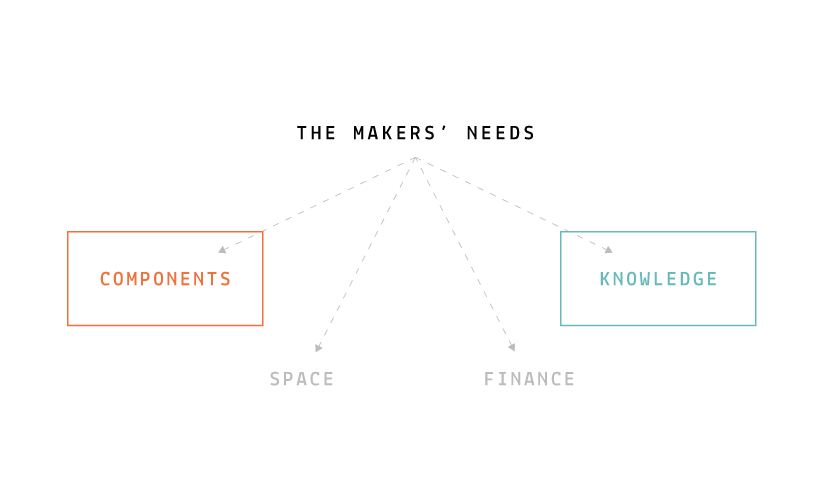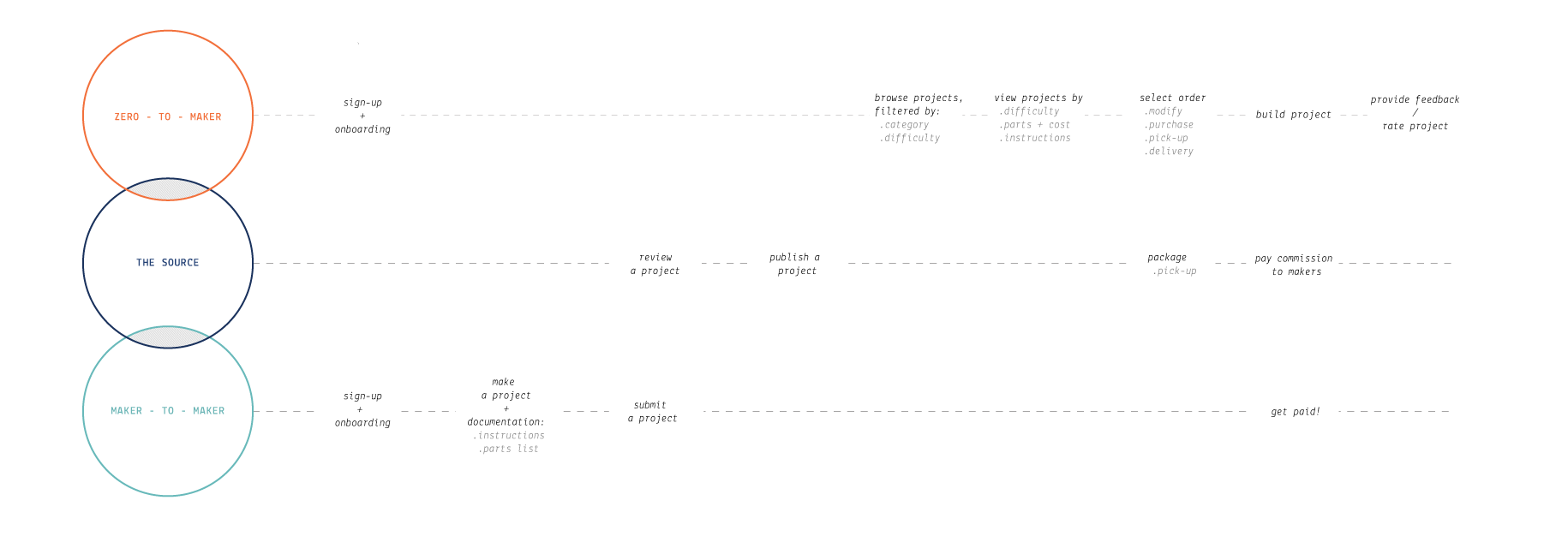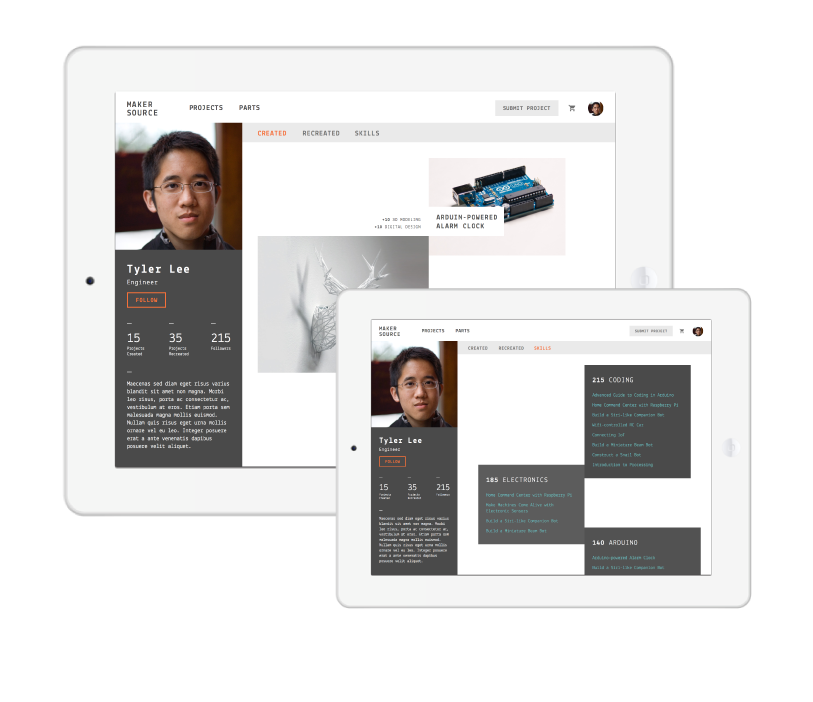
Maker Source
Maker Source is an online platform for prospective and experienced makers to build projects, acquire skills, buy components and share their knowledge with each other.
Designed around the maker’s ethos of open source, it provides a holistic experience for prospective and experienced makers by facilitating open knowledge sharing and acquisition of supplies (electronic components).
view final presentationhere
view process bookhere
Role
- UX Design
- UX Strategy
- User Research
- Process Book Direction
Team
- Azat Bayandin
- Charlie Chao
- Daria Ershova
- Solomon Hsu
- Edwy Woo
Tools
- Interviews
- Sketch
- Framer
- Adobe Suite
- Physical Prototyping
PROMO VIDEO

THE OPPORTUNITY
In the maker’s area, we saw two factors that empower the Maker Movement: the availability of affordable supplies and the open learning and sharing nature of the community. During our research we found that both the supplies and the knowledge sources are scattered across many different locations which makes it harder for new makers to join the movement.
This presented us an opportunity to create a unified platform that bridges the gap between a potential retailer and the maker community.
View market gap analysishere
THE CLIENT
Currently, The Source is losing sales in a highly competitive consumer electronics retail space because of its inability to compete with larger retailers that offer “big box” formats and everyday low pricing. We found an opportunity for non “bog box” retailers (such as the Source) to reframe their audience to the fast-growing market of makers where it can establish its dominance and create a following of loyal customers.
We wanted the Source to be an embodiment of open-source nature of the maker movement by transforming them into a facilitator of learning and sharing within the maker community.

DESIGN FOCUS
According to Dale Dougherty, the founder of Maker Faire, there are three segments or stages of makers — zero-to-maker, maker-to-maker, and maker-to-market. We focused on zero-to-makers and maker-to-makers as they’re the fastest growing segments and on the maker’s ethos of open-source. Open-source in this context means to encourage universal access to knowledge and ideas, as well as being able to freely create derivative works.
View personas here
MAKER MOVEMENT PRINCIPLES
As designed the website, we kept in mind what our audience values in order to resonate with them within the website itself:
- Learning through doing
- Embracing imperfection
- Focusing on the process
- Social environment
- Open-source and open-design
View value diagram here


MUTUALISTIC SYMBIOSIS
To create a cycle of engagement for our audience, we devised a simple model on how the stakeholders would be able to benefit each other on the platform:
- A maker-to-maker creates and submits a project instruction
- The Source quality checks it and publishes it
- A zero-to-maker finds the project and buys the required parts directly through the website
- The Source commissions the project author for every purchase
JOURNEY FRAMEWORK

ADDRESSING SYSTEMIC PAINT POINTS
Besides identifying individual goals and maker culture needs, we also determined systemic pain points that our platform could address: the friction between marginalized communities of makers and mainstream markets and the resulting lack of validation and support systems for edge makers. By emphasizing the value of everyone’s participation and offering validation of achievements via. sharing we could help makers to move from the extreme margins to mainstream and challenge the visibility of the movement.
CORE EXPERIENCES
Based on our audience’s needs, values, and goals, we decided to focus on five core experiences within the platform:
- Discovery
- Profile
- Project view
- Authoring
- Purchase

Discovery: Categories
To address the systematic discovery of projects, we decided to show categories based on features rather than the specific technology (e.g., soldering), specific products (e.g., Arduino), or broad segments (e.g., electronics).
This way of organization lowers the cognitive overhead for beginners to browse projects as no technical knowledge of the makers domain is required to get a sense of what’s in the platform.
Discovery: "Magnetizing"
We wanted the discovery experience to be very minimal, in which it could entice our audience’s curiosity through beautiful imagery. The website shows additional project details when the user hover or tap once over the box.
In addition, we introduced an “magnetizing” function for each project that repels all the projects on the screen and attracts only the related ones. This allows for the members of the audience with limited maker knowledge to browse by their own intuition and interests.
PROFILE: GROWTH
Embracing “Everyone’s a maker” principle allowed us to come up with a skill - project reference system that rewards contribution and systematic participation. The platform is all inclusive and all makers regardless their levels are considered to be makers. In regards to building projects the only differentiation that happens is whether or not the project was created (original idea) or re-created (build on someone’s idea).

PROFILE: VALIDATION
In order to provide further validation of skills and encourage makers to build their skills systematically, we created a skill level system that awards skills points based on a type of a project and specific skills used in it.
Makers can mark a project as completed to add it to their profile. Over time, they will be able to see a progress of their created and recreated projects with the skills they’ve learned for each project. We use a skill points system here to show measurable growth for each individual.
AUTHORING: STEP-BY-STEP
Because makers are the primary content creator for our platform, we designed an authoring tool that lets them effortlessly upload and contribute the instructions for their projects to the community. This experience resonates with their value of focusing on the process by showing them a layout for creating digestible step-by-step instructions instead of asking them to write a freeform article.
AUTHORING: CONTENT POPULATION
When makers create a new project, they can jump right into populating the content. Although uploading a video is preferred, we made it optional in order to avoid a high submission barrier. If the author uploads a video, we made it simple for makers to add digestible step-by-step instructions alongside their media so that they can focus on documenting their process quickly.
This rich media flexibility enables them to create visual and informational content that caters well to the zero-to-makers.
AUTHORING: CONTENT POPULATION

PROJECT VIEW
We mapped out the way users would move through instructions in various situations. By having one step shown at a time, we made it easy for viewers to follow along with the video. In addition, within each step, relevant links are shown in order to further engage the reader. The video has pins that map to text instructions, thus enabling every user to follow the instructions at his own pace and rhythm.
Readers are also allowed to provide feedback to the creator during each step, thereby creating a social environment where they can learn from each other.
PROJECT VIEW

PURCHASE FLOW
Finally, we have the purchasing process, which has been integrated directly into the flow, allowing our audience to get the required components for the project quickly and reliably from The Source. The key goal was to create a system that is accessible to everyone and is easy to follow - a list of components is formed in relationship to the project and can be modified before being added to the cart.
Purchase process is incorporated seamlessly, thus enabling new makers to focus on the building process and to not waste their time by looking for the right components somewhere else.